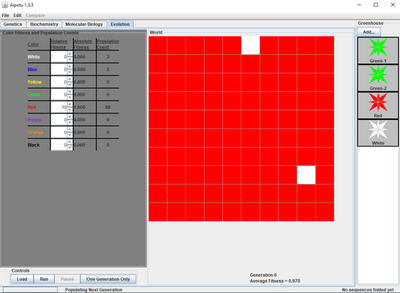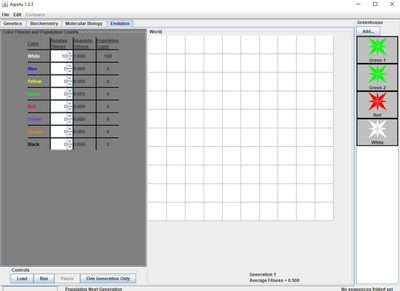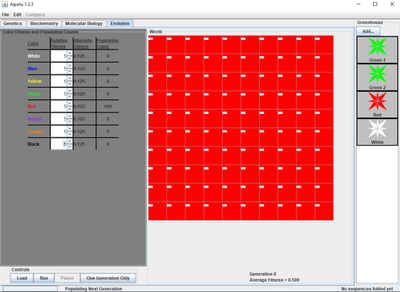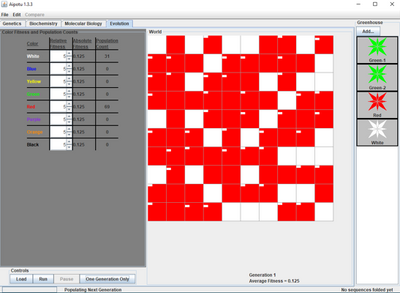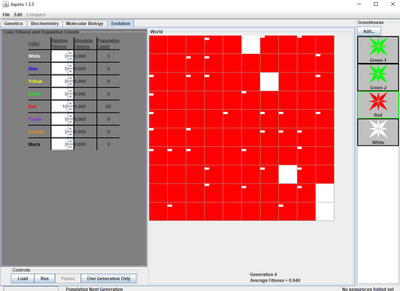Cdominguez Week 2
Purpose
To interact with a model in order to further understand more about the genetics, molecular biology, biochemistry, and evolution of a dataset and become familiar with the use of modeling in bioinformatics.
Methods/Results
- Opened Aipotu on computer
- Clicked on Evolution tab
- Turned off mutations by clicking on "mutation rates" and unchecking box for "mutations enabled"
- Selected red and white in Greenhouse and clicked load button
- Set fitness setting to 10 for red and 0 for others
- Predicted results based on these methods
A4) Prediction: The flowers should mostly be red since it has the highest fitness as compared to the other colors, including white.
- Clicked One Generation Only in the controls
A6) As I simulate more generations, there are more red flowers and less white flowers and eventually all red flowers. It took about 14 generations to to get pure red that did not result in any more white offspring. This is due to the red color being dominant over white and thus a heterozygous flower still has the white allele although its phenotype is red. When two heterozygous flowers are crossed, it can result in a white flower when it is homozygous recessive for white.
- Selected red and white in Greenhouse and click load button
- Set fitness to 10 for white and 0 for others
- Predicted results based on these methods
B4) Prediction: The flowers should be mostly white if the genotype for white flowers is homozygous recessive, then it should only always produce white phenotype.
- Clicked on One Generation Only in Controls
B6) The flowers continue to only be white with no red flowers. It only took one generation to get pure white. It takes less generations to get pure white than pure red because the original white flower must have been homozygous recessive so all of its offspring will then be homozygous recessive as well or pure white. The red phenotype is dominant over other alleles so the recessive allele could be present in earlier generations but is masked. This results in white phenotype flowers and more generations before the white phenotype absent and only the red allele and phenotype remained.
- Selected Red organism from Greenhouse
- Selected "Show colors of both alleles" in the World Settings part of Preferences
- Set all fitness to 5
- Calculated HWE for resulting data:
C3/C6) No, it is not in HWE. with a p2=0.25 and q2=0.25 and 2pq=0.5, we would expect 25 RR, 25 Rr, and 50 rr; however, we see 100 of Rr. A chi squared test resulted in x2=100, which is higher than the theoretical value of 3.841. Therefore, it is not in HWE.
| Genotype | Number | #R's | #r's |
|---|---|---|---|
| RR | 0 | 0 | 0 |
| Rr | 100 | 100 | 100 |
| rr | 0 | 0 | 0 |
| Total | 100 | 100 |
frequency of R (p)= 0.5 frequency of r (q)= 0.5 frequency of RR= 0.25 frequency of Rr=0.5 frequency of rr=0.25
- Clicked on one generation run
- Calculated HWE for following data:
C7) With a p2=0.26 and q2=0.24 and 2pq=0.12, we would expect 26 RR, 24 rr, and 50 Rr and we see 29 RR, 44 Rr, and 27 rr. A chi squared test resulted in X2=0.495 which is smaller than the cutoff of the critical value of 6.635 therefore this population is in HWE.
| Genotype | Number | #R's | #r's |
|---|---|---|---|
| RR | 29 | 58 | 0 |
| Rr | 44 | 44 | 44 |
| rr | 27 | 0 | 54 |
| Total | 102 | 98 |
frequency of R (p)= 0.51 frequency of r (q)= 0.49 frequency of RR= 0.26 frequency of Rr=0.12 frequency of rr=0.24
- Set red fitness to 10 and others to 0
C9) After several generations, p and q should be closer to 0.5 as it starts to be in HWE due to red being dominant over other phenotypes.
- Clicked One Generation Only button in Controls a few times
- Calculated HWE for the following data:
| Genotype | Number | #R's | #r's |
|---|---|---|---|
| RR | 84 | 168 | 0 |
| Rr | 16 | 16 | 16 |
| rr | 0 | 0 | 0 |
| Total | 184 | 16 |
frequency of R (p)= 0.92 frequency of r (q)= 0.08 frequency of RR= 0.84 frequency of Rr=0.01 frequency of rr=0.0064
C11) No, it did not match my prediction. Instead I had p=0.92 for the frequency of R (p) and q=0.08 for the frequency of r. Upon further thought, this makes more sense as there should be a greater frequency of R (p) due to its higher fitness in the population and its dominance over other alleles.
Data and Files
None
Conclusion
In the evolutionary section of Aipotu, it was found that red is dominant over the white phenotype further proving what the genetics team discovered about the alleles. It took several generations to obtain pure red due to its dominant phenotype causing heterozygous flowers to appear red but still carry the recessive white allele. However, with a high fitness for white, it took only one generation to obtain pure white demonstrating the white phenotype is homozygous recessive. With equal fitness of all colors, the population was shown to be in HWE; however, when red was placed as a higher fitness then HWE was not achieved.
Acknowledgments
- I worked with user:Jennymchua and user:Carolyne for this assignment during class where we discussed the assignment and answers.
- Except for what is noted above, this individual journal entry was completed by me and not copied from another source.
Cdominguez (talk) 15:50, 23 January 2020 (PST)
